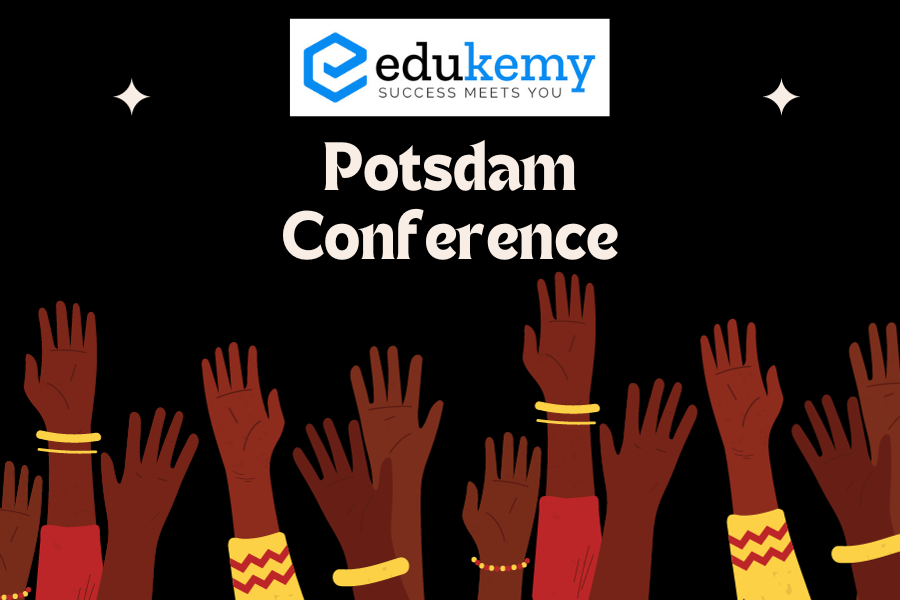
The Potsdam Conference, held in occupied Germany, was a critical event following the end of World War II. Attended by Stalin, Truman (who had succeeded Roosevelt), and initially Churchill (later replaced by Clement Attlee), it led to significant agreements:
- German Disarmament: Germany’s disarmament was agreed upon. The conference outlined plans to eliminate Germany’s capacity for war by either dismantling or bringing under control all industrial facilities engaged in military production.
- Economic Measures for Germany: a) It was decided that the standard of living in Germany should not exceed the average in Europe. Additionally, the extent and type of German industry to be dismantled to achieve this goal would be determined later. This included capping German steel production and reducing its heavy industry to half of the 1938 levels, among other measures. b) Most German reparations were designated for the USSR, which had sustained significant damage during the war. The USSR gained the right to take non-food goods from its occupation zone in Germany, as well as from the Western zone, provided it met the food supply needs of the Western zone.
- German Frontiers: a) Occupation Zones: Germany, along with Austria and their respective capitals, Berlin and Vienna, were divided into four occupation zones. This had been previously agreed upon in principle at Yalta and was confirmed at the Potsdam Conference. b) Oder-Neisse Line: Germany’s eastern border was temporarily shifted westward to the Oder-Neisse line. This shift was agreed to be temporary, with the final delineation of Germany’s eastern border to be determined later (which ultimately happened under the Treaty of Final Settlement for Germany in 1990). This effectively reduced the size of Germany to three-fourths of its 1937 borders. Territories east of the new border were designated to Poland and included East Prussia, Silesia, West Prussia, and the majority of Pomerania.
- De-Nazification and Trials: The Nazi Party was to be disbanded, and individuals associated with it were to be tried as war criminals. These trials became internationally known as the Nuremberg trials.
- Demographic Changes: The orderly and humane expulsion of Germans residing beyond the new eastern border, the Oder-Neisse line, from Poland, Hungary, and Czechoslovakia was agreed upon.
Contents
- 1 However, notable points of disagreement and dissatisfaction arose:
- 2 Frequently Asked Questions (FAQs)
- 2.1 1. What was the Potsdam Conference?
- 2.2 2. Who were the main participants in the Potsdam Conference?
- 2.3 3. What were the major decisions made at the Potsdam Conference?
- 2.4 4. How did the Potsdam Conference contribute to the Cold War?
- 2.5 5. What was the significance of the Potsdam Conference in shaping the post-war world?
- 3 In case you still have your doubts, contact us on 9811333901.
However, notable points of disagreement and dissatisfaction arose:
- Disagreement persisted regarding the potential and timing of unifying the four zones of Germany.
- There were reservations about the presence of Russian troops occupying German territory east of the Oder-Neisse line, which was administered by the communist Polish government. Britain and the U.S. expressed discontent over this arrangement, despite agreeing to the temporary shift of the German frontier.
- Concerns were raised regarding the atomic bombing of Japan. While Churchill was informed of the U.S. plan during the conference, Stalin was not informed. The bomb was subsequently dropped two days after the conference.
The Potsdam Conference was instrumental in shaping the trajectory of post-war Germany and Europe, setting the stage for the complex geopolitical dynamics of the Cold War era.
Frequently Asked Questions (FAQs)
1. What was the Potsdam Conference?
The Potsdam Conference was a meeting held among the Allied leaders of World War II from July 17 to August 2, 1945, in Potsdam, Germany. The conference aimed to discuss the post-war order, the administration of defeated Germany, and the fate of the territories liberated from Nazi control.
2. Who were the main participants in the Potsdam Conference?
The key participants were the leaders of the Allied powers: Harry S. Truman (United States), Joseph Stalin (Soviet Union), and Winston Churchill (later replaced by Clement Attlee from July 26, 1945, after the British general election).
3. What were the major decisions made at the Potsdam Conference?
The conference resulted in important agreements on the division and administration of Germany, the denazification process, and the post-war borders of Europe. It also addressed the issue of war reparations and the establishment of the United Nations.
4. How did the Potsdam Conference contribute to the Cold War?
The Potsdam Conference is often considered a prelude to the Cold War. Tensions between the Western Allies and the Soviet Union became evident during the conference, particularly regarding the division of Germany and the influence in Eastern Europe. These differences laid the groundwork for the ideological and political conflict that characterized the Cold War.
5. What was the significance of the Potsdam Conference in shaping the post-war world?
The Potsdam Conference played a crucial role in shaping the post-war world by establishing the framework for the occupation and reconstruction of Germany, addressing the consequences of war, and setting the stage for the geopolitical landscape of the Cold War era. It laid the foundation for international cooperation through the creation of the United Nations and influenced the course of events in Europe for decades to come.
In case you still have your doubts, contact us on 9811333901.
For UPSC Prelims Resources, Click here
For Daily Updates and Study Material:
Join our Telegram Channel – Edukemy for IAS
- 1. Learn through Videos – here
- 2. Be Exam Ready by Practicing Daily MCQs – here
- 3. Daily Newsletter – Get all your Current Affairs Covered – here
- 4. Mains Answer Writing Practice – here

